Unveiling Forest Density Dynamics in Saihanba Forest Farm by Integrating Airborne LiDAR and Landsat Satellites
Abstract
Highlights
- Multi-seasonal inputs significantly outperformed single-season Landsat data in estimating tree density, exhibiting superior model accuracy and generalization.
- Supports ecological evaluation of large-scale afforestation in Saihanba based on produced five-year interval tree density maps (1988–2023), demonstrating the utility of multi-source remote sensing for tracking forest recovery over time.
Abstract
1. Introduction
2. Study Area and Data
2.1. Study Area
2.2. Data and Preprocessing
2.2.1. Airborne LiDAR Data
2.2.2. Satellite Imagery
3. Method
3.1. Feature Extraction
3.2. Derivation of Tree Density from LiDAR Data
3.3. Random Forest Regression
3.4. Support Vector Regression
3.5. XGBoost Regression
3.6. Model Evaluation Metrics
3.6.1. Coefficient of Determination (R2)
3.6.2. Root Mean Square Error (RMSE)
4. Results
4.1. Model Accuracy Evaluation
4.2. Time-Series Results and Analysis
4.3. Forest Density Changes Across Ecological Function Zones
4.4. Forest Density Changes Across Slope Gradients
5. Discussion
5.1. Impact of Tree Species on Training Error
5.2. Impact of Seasonal Data Configuration on Training Error
5.3. Spatial Distribution of Tree Density Change Rates
6. Conclusions
Author Contributions
Funding
Data Availability Statement
Acknowledgments
Conflicts of Interest
References
- Xu, X.L.; Cao, M.K.; Li, K.R. Temporal-Spatial Dynamics of Carbon Storage of Forest Vegetation in China. Prog. Geogr. 2007, 26, 1–10. [Google Scholar]
- Dubrovin, I.; Fortin, C.; Kedrov, A. An open dataset for individual tree detection in UAV LiDAR point clouds and RGB orthophotos in dense mixed forests. Sci. Rep. 2024, 14, 21938. [Google Scholar] [CrossRef]
- Zeide, B. How to Measure Stand Density. Trees 2005, 19, 1–14. [Google Scholar] [CrossRef]
- Hansen, M.C.; Potapov, P.V.; Moore, R.; Hancher, M.; Turubanova, S.A.; Tyukavina, A.; Thau, D.; Stehman, S.V.; Goetz, S.J.; Loveland, T.R.; et al. High-Resolution Global Maps of 21st-Century Forest Cover Change. Science 2013, 342, 850–853. [Google Scholar] [CrossRef] [PubMed]
- Fassnacht, F.E.; Mangold, D.; Schäfer, J.; Immitzer, M.; Kattenborn, T.; Koch, B.; Latifi, H. Estimating Stand Density, Biomass and Tree Species from Very High Resolution Stereo-Imagery–Towards an All-in-One Sensor for Forestry Applications? Forestry 2017, 90, 613–631. [Google Scholar] [CrossRef]
- Guo, W.; Yang, C.Y.; Wu, Z.R.; Ji, X.L.; Yang, C.J.; Zhao, C.W.; Zhang, Y.H. Forest Density Mapping Based on UAV High-Resolution Image. Bull. Surv. Map. 2021, 07, 29–33. [Google Scholar] [CrossRef]
- Sun, H.; Guo, X.Y.; Zhang, H.Y.; Zhao, J.J. Estimating Canopy Bulk Density and Canopy Base Height Using UAV LiDAR and Multispectral Images. Natl. Remote Sens. Bull. 2024, 28, 3107–3122. [Google Scholar] [CrossRef]
- Crowther, T.W.; Glick, H.B.; Covey, K.R.; Bettigole, C.; Maynard, D.S.; Thomas, S.M.; Smith, J.R.; Hintler, G.; Duguid, M.C.; Amatulli, G.; et al. Mapping Tree Density at a Global Scale. Nature 2015, 525, 201–205. [Google Scholar] [CrossRef] [PubMed]
- Zhang, Z.; Dong, X.; Tian, J.; Tian, Q.; Xi, Y.; He, D. Stand Density Estimation Based on Fractional Vegetation Coverage from Sentinel-2 Satellite Imagery. Int. J. Appl. Earth Obs. Geoinf. 2022, 108, 102760. [Google Scholar] [CrossRef]
- Humagain, K.; Portillo-Quintero, C.; Cox, R.; Cain, J. Mapping Tree Density in Forests of the Southwestern USA Using Landsat 8 Data. Forests 2017, 8, 287. [Google Scholar] [CrossRef]
- Chrysafis, I.; Mallinis, G.; Gitas, I.; Tsakiri-Strati, M. Estimating Mediterranean Forest Parameters Using Multi Seasonal Landsat 8 OLI Imagery and an Ensemble Learning Method. Remote Sens. Environ. 2017, 199, 154–166. [Google Scholar] [CrossRef]
- Sivanpillai, R.; Smith, C.T.; Srinivasan, R.; Messina, M.G.; Wu, X.B. Estimation of Managed Loblolly Pine Stand Age and Density with Landsat ETM+ Data. For. Ecol. Manag. 2006, 223, 247–254. [Google Scholar] [CrossRef]
- LaRue, E.; Wagner, F.; Fei, S.; Atkins, J.; Fahey, R.; Gough, C.; Hardiman, B. Compatibility of Aerial and Terrestrial LiDAR for Quantifying Forest Structural Diversity. Remote Sens. 2020, 12, 1407. [Google Scholar] [CrossRef]
- White, J.C.; Coops, N.C.; Wulder, M.A.; Vastaranta, M.; Hilker, T.; Tompalski, P. Remote Sensing Technologies for Enhancing Forest Inventories: A Review. Can. J. Remote Sens. 2016, 42, 619–641. [Google Scholar] [CrossRef]
- Packalen, P.; Vauhkonen, J.; Kallio, E.; Peuhkurinen, J.; Pitkänen, J.; Pippuri, I.; Strunk, J.; Maltamo, M. Predicting the Spatial Pattern of Trees by Airborne Laser Scanning. Int. J. Remote Sens. 2013, 34, 5154–5165. [Google Scholar] [CrossRef]
- Pang, Y.; Li, Z.; Ju, H.; Lu, H.; Jia, W.; Si, L.; Guo, Y.; Liu, Q.; Li, S.; Liu, L.; et al. LiCHy: The CAF’s LiDAR, CCD and Hyperspectral Integrated Airborne Observation System. Remote Sens. 2016, 8, 398. [Google Scholar] [CrossRef]
- Mohammadi, J.; Shataee Joibary, S.; Yaghmaee, F.; Mahiny, A.S. Modelling Forest Stand Volume and Tree Density Using Landsat ETM+ Data. Int. J. Remote Sens. 2010, 31, 2959–2975. [Google Scholar] [CrossRef]
- Bulut, S.; Günlü, A.; Çakır, G. Modelling Some Stand Parameters Using Landsat 8 OLI and Sentinel-2 Satellite Images by Machine Learning Techniques: A Case Study in Türkiye. Geocarto Int. 2023, 38, 2158238. [Google Scholar] [CrossRef]
- Joshi, C.; Leeuw, J.D.; Skidmore, A.K.; Duren, I.C.V.; van Oosten, H. Remotely Sensed Estimation of Forest Canopy Density: A Comparison of the Performance of Four Methods. Int. J. Appl. Earth Obs. Geoinf. 2006, 8, 84–95. [Google Scholar] [CrossRef]
- Kahriman, A.; Günlü, A.; Karahalil, U. Estimation of Crown Closure and Tree Density Using Landsat TM Satellite Images in Mixed Forest Stands. J. Indian Soc. Remote Sens. 2014, 42, 559–567. [Google Scholar] [CrossRef]
- Sismanis, M.; Gitas, I.Z.; Georgopoulos, N.; Stavrakoudis, D.; Gkounti, E.; Antoniadis, K. A Spectral–Spatial Approach for the Classification of Tree Cover Density in Mediterranean Biomes Using Sentinel-2 Imagery. Forests 2024, 15, 2025. [Google Scholar] [CrossRef]
- Su Mon, M.; Mizoue, N.; Htun, N.Z.; Kajisa, T.; Yoshida, S. Estimating Forest Canopy Density of Tropical Mixed Deciduous Vegetation Using Landsat Data: A Comparison of Three Classification Approaches. Int. J. Remote Sens. 2012, 33, 1042–1057. [Google Scholar] [CrossRef]
- Yang, H.; Wang, S.; Son, R.; Lee, H.; Benson, V.; Zhang, W.; Zhang, Y.; Zhang, Y.; Kattge, J.; Boenisch, G.; et al. Global Patterns of Tree Wood Density. Glob. Change Biol. 2024, 30, e17224. [Google Scholar] [CrossRef]
- Lozano-Tello, A.; Luceño, J.; Caballero-Mancera, A.; Clemente, P.J. Estimating Olive Tree Density in Delimited Areas Using Sentinel-2 Images. Remote Sens. 2025, 17, 508. [Google Scholar] [CrossRef]
- Mouafik, M.; Mounir, F.; Aboudi, A.E. Integrating Multi-Source Remote Sensing Data and Machine Learning for Predicting Tree Density and Cover in Argania spinosa. Smart Agric. Technol. 2025, 11, 100911. [Google Scholar] [CrossRef]
- Kang, J.; Qing, Y.; Lu, W. Construction and Optimization of the Saihanba Ecological Network. Ecol. Indic. 2023, 153, 110401. [Google Scholar] [CrossRef]
- Tao, C.; Guo, T.; Shen, M.; Tang, Y. Spatio-Temporal Dynamic of Disturbances in Planted and Natural Forests for the Saihanba Region of China. Remote Sens. 2023, 15, 4776. [Google Scholar] [CrossRef]
- Hu, Y.J.Q.; Xiao, J.; Yu, B.W.; Xu, W.H. Research Progress in Function Zoning of Nature Reserves in China. Acta Ecol. Sin. 2014, 34, 6391–6396. [Google Scholar] [CrossRef]
- Zhang, W.; Qi, J.; Wan, P.; Wang, H.; Xie, D.; Wang, X.; Yan, G. An Easy-to-Use Airborne LiDAR Data Filtering Method Based on Cloth Simulation. Remote Sens. 2016, 8, 501. [Google Scholar] [CrossRef]
- Wulder, M.A.; White, J.C.; Goward, S.N.; Masek, J.G.; Irons, J.R.; Herold, M.; Cohen, W.B.; Loveland, T.R.; Woodcock, C.E. Landsat Continuity: Issues and Opportunities for Land Cover Monitoring. Remote Sens. Environ. 2008, 112, 955–969. [Google Scholar] [CrossRef]
- Wulder, M.A.; White, J.C.; Loveland, T.R.; Woodcock, C.E.; Belward, A.S.; Cohen, W.B.; Fosnight, E.A.; Shaw, J.; Masek, J.G.; Roy, D.P. The Global Landsat Archive: Status, Consolidation, and Direction. Remote Sens. Environ. 2016, 185, 271–283. [Google Scholar] [CrossRef]
- Zhu, Z.; Woodcock, C.E. Object-Based Cloud and Cloud Shadow Detection in Landsat Imagery. Remote Sens. Environ. 2012, 118, 83–94. [Google Scholar] [CrossRef]
- Li, Y.; Xie, D.; Wang, Y.; Jin, S.; Zhou, K.; Zhang, Z.; Li, W.; Zhang, W.; Mu, X.; Yan, G. Individual Tree Segmentation of Airborne and UAV LiDAR Point Clouds Based on the Watershed and Optimized Connection Center Evolution Clustering. Ecol. Evol. 2023, 13, e10297. [Google Scholar] [CrossRef] [PubMed]
- Xie, D.H.; Li, Y.; Zhou, K.; Zhang, Z.X.; Jin, L.; Yan, G.J.; Mu, X.H.; Li, W.H.; Feng, G.Y. Information Extraction and System Construction of Digital Forest System Based on Multisource Remote Sensing Data. Natl. Remote Sens. Bull. 2024, 28, 1281–1294. [Google Scholar] [CrossRef]
- Breiman, L. Random Forests. Mach. Learn. 2001, 45, 5–32. [Google Scholar] [CrossRef]
- Tian, Y. Support Vector Regression and Its Application. Ph.D. Thesis, China Agricultural University, Beijing, China, 2005. [Google Scholar]
- Chen, T.; Guestrin, C. XGBoost: A Scalable Tree Boosting System. In Proceedings of the 22nd ACM SIGKDD International Conference on Knowledge Discovery and Data Mining, San Francisco, CA, USA, 13–17 August 2016; pp. 785–794. [Google Scholar] [CrossRef]
- Cheng, K.; Yang, H.; Chen, Y.; Yang, Z.; Ren, Y.; Zhang, Y.; Lin, D.; Liu, W.; Huang, G.; Xu, J.; et al. How Many Trees Are There in China? Sci. Bull. 2025, 70, 1076–1079. [Google Scholar] [CrossRef]
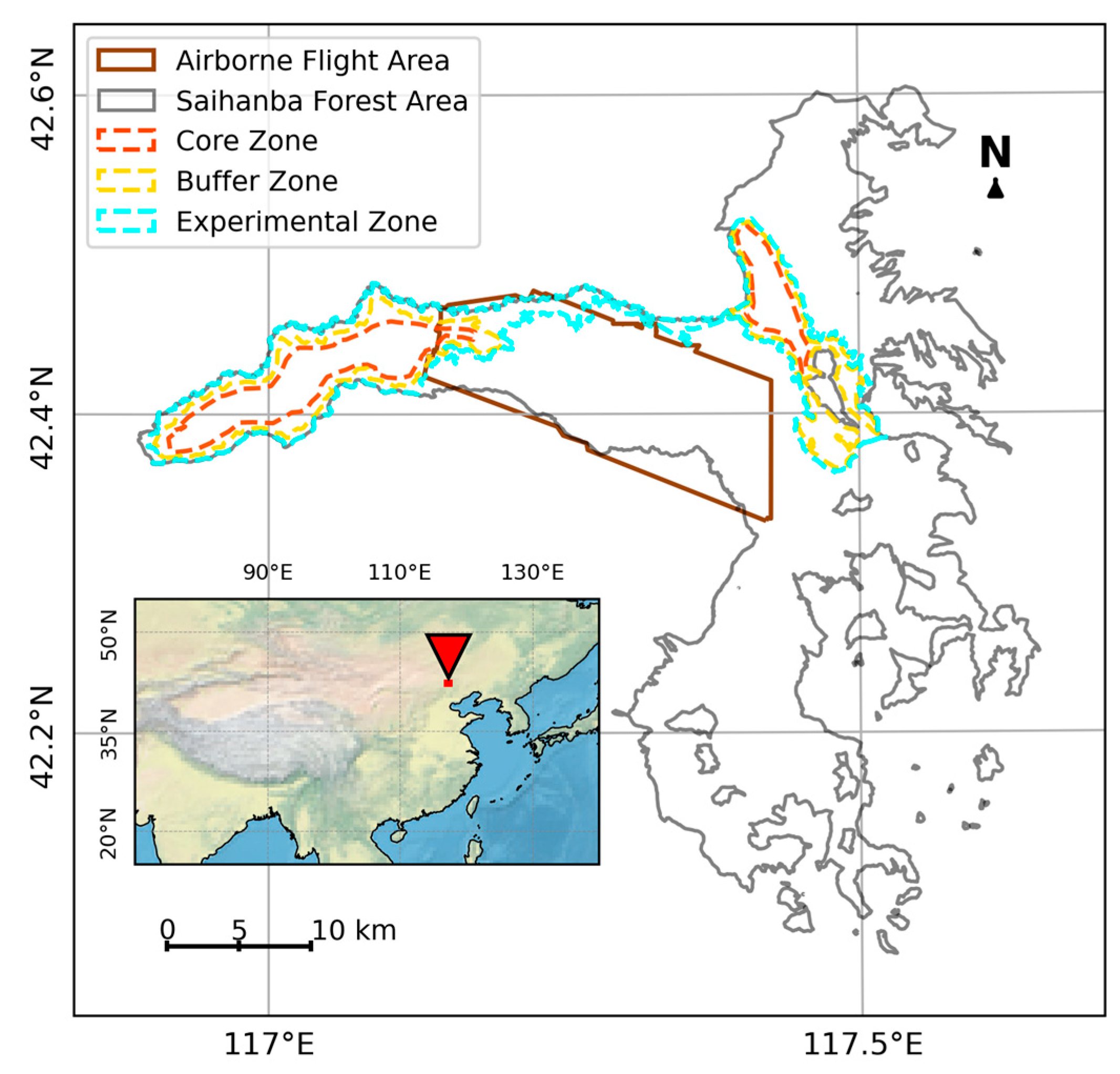

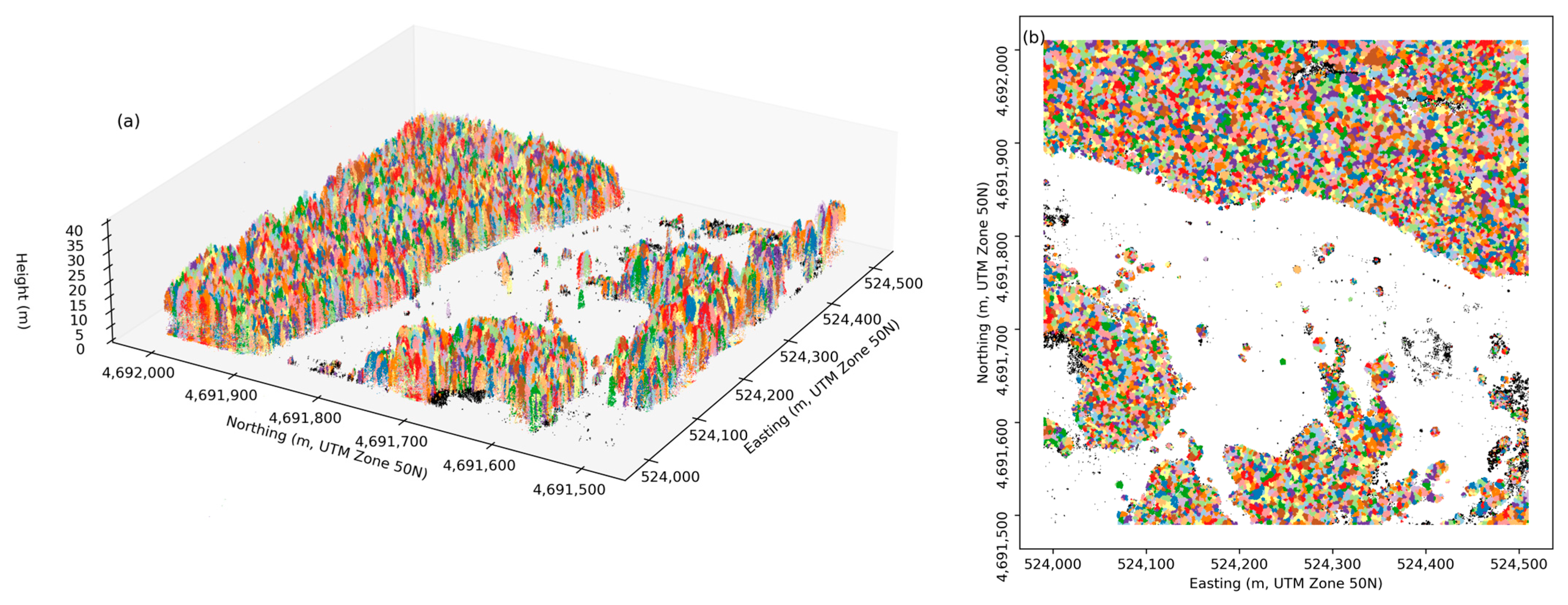


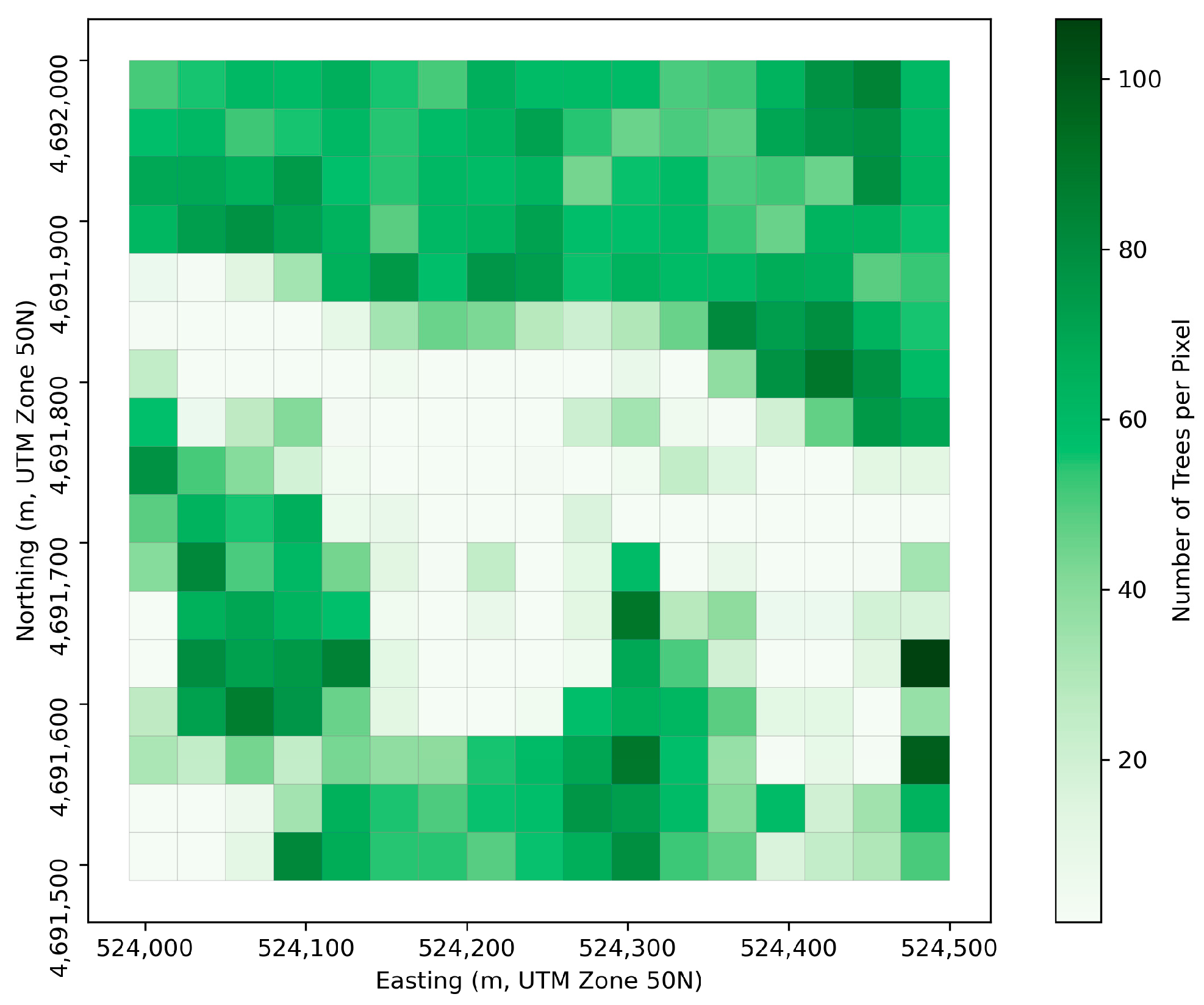





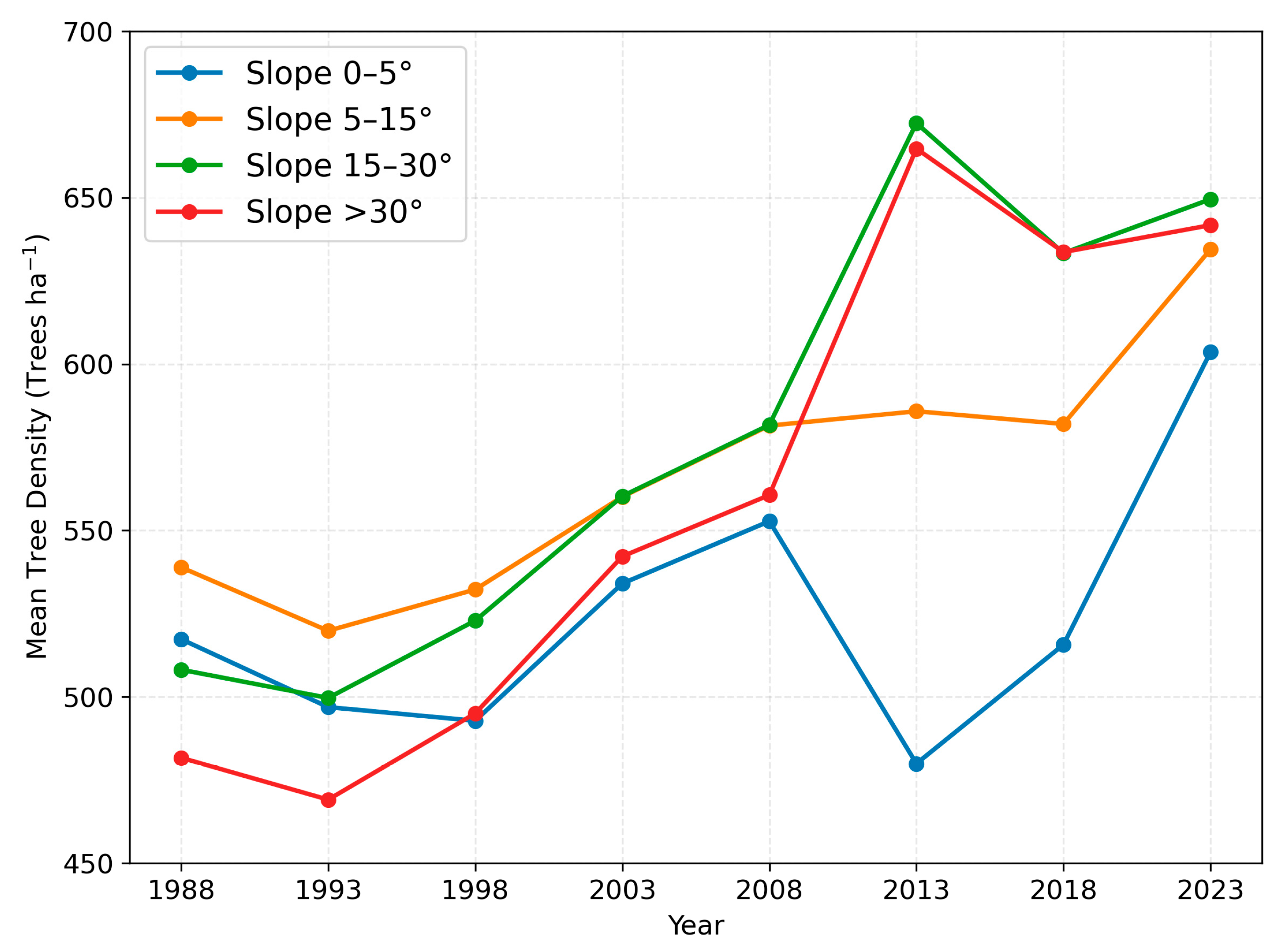
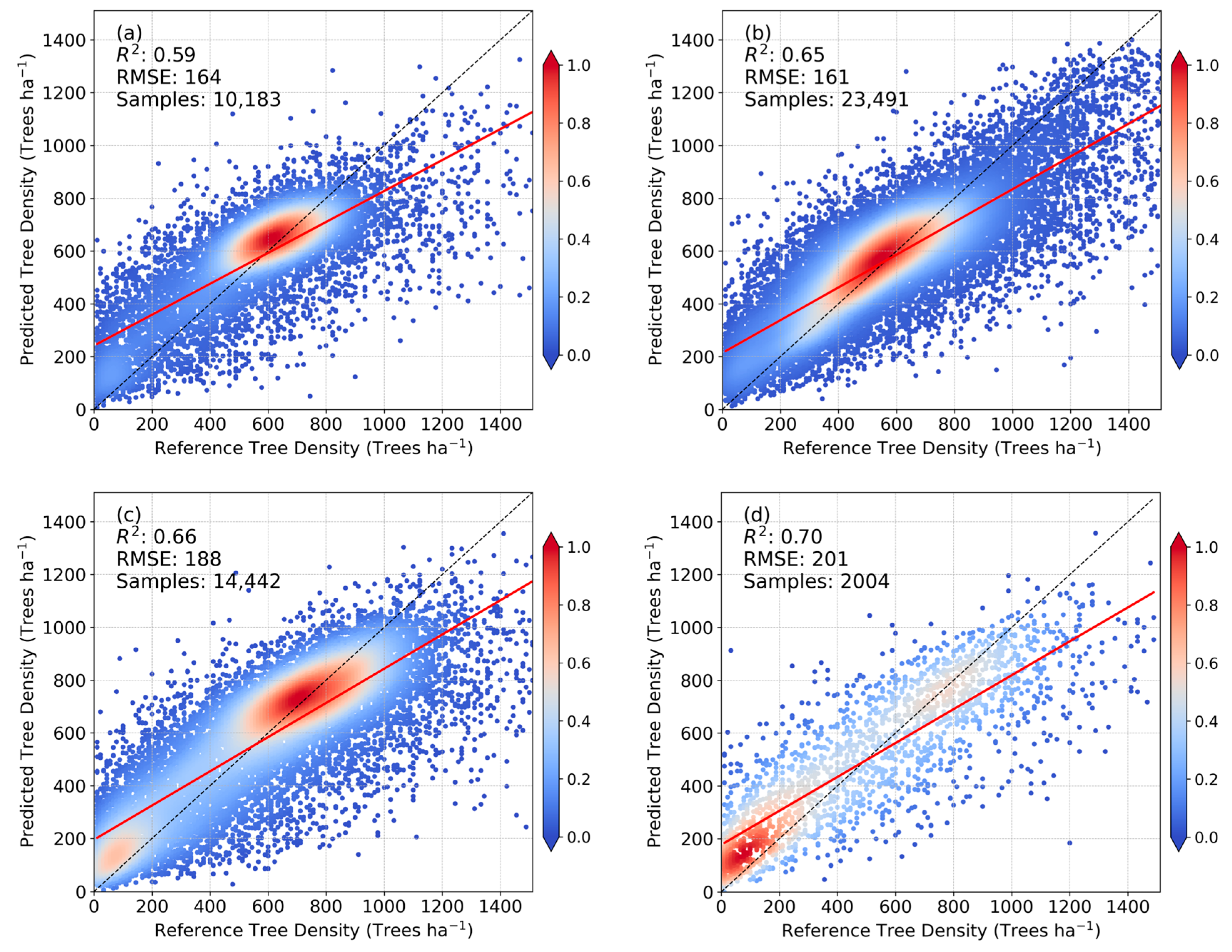
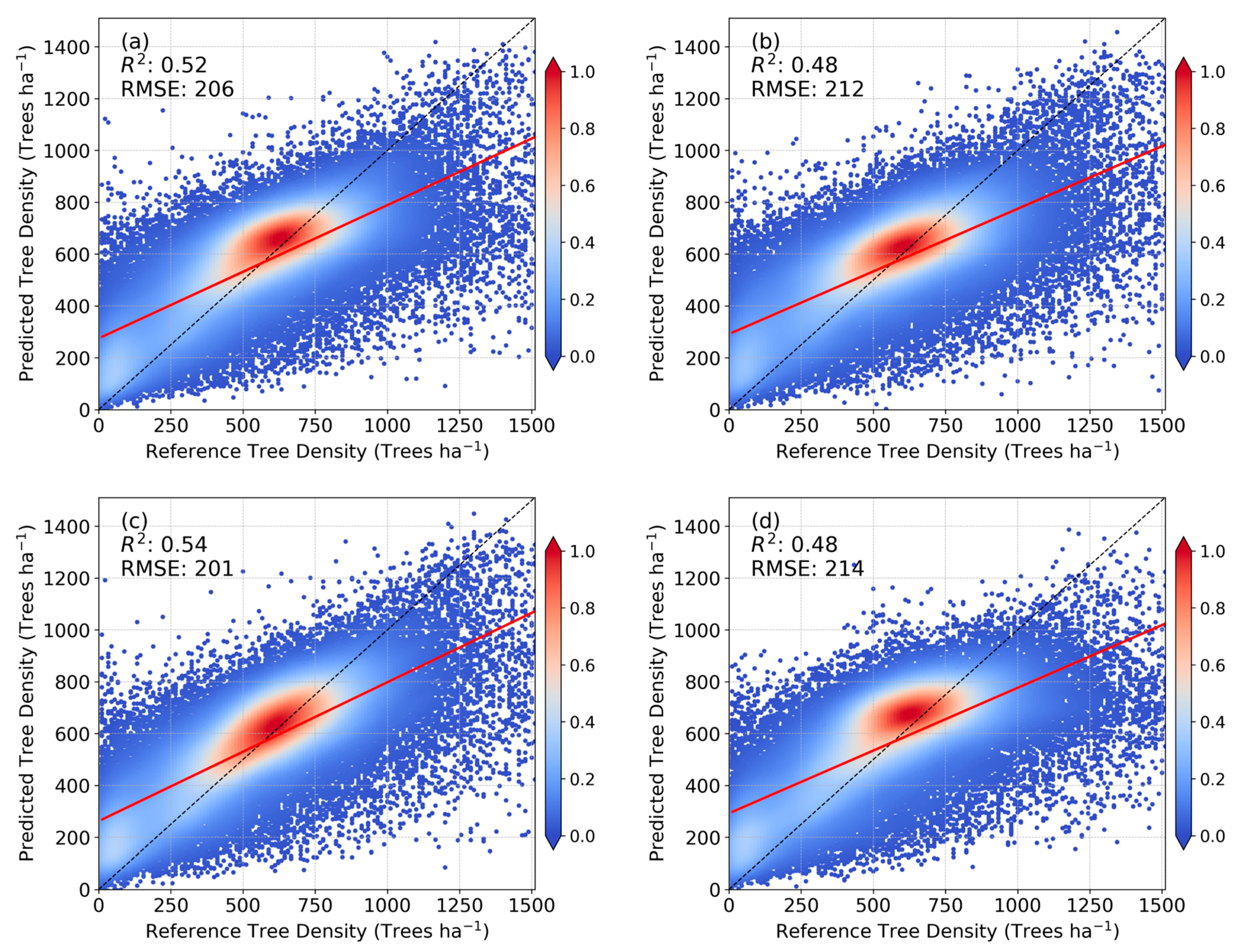
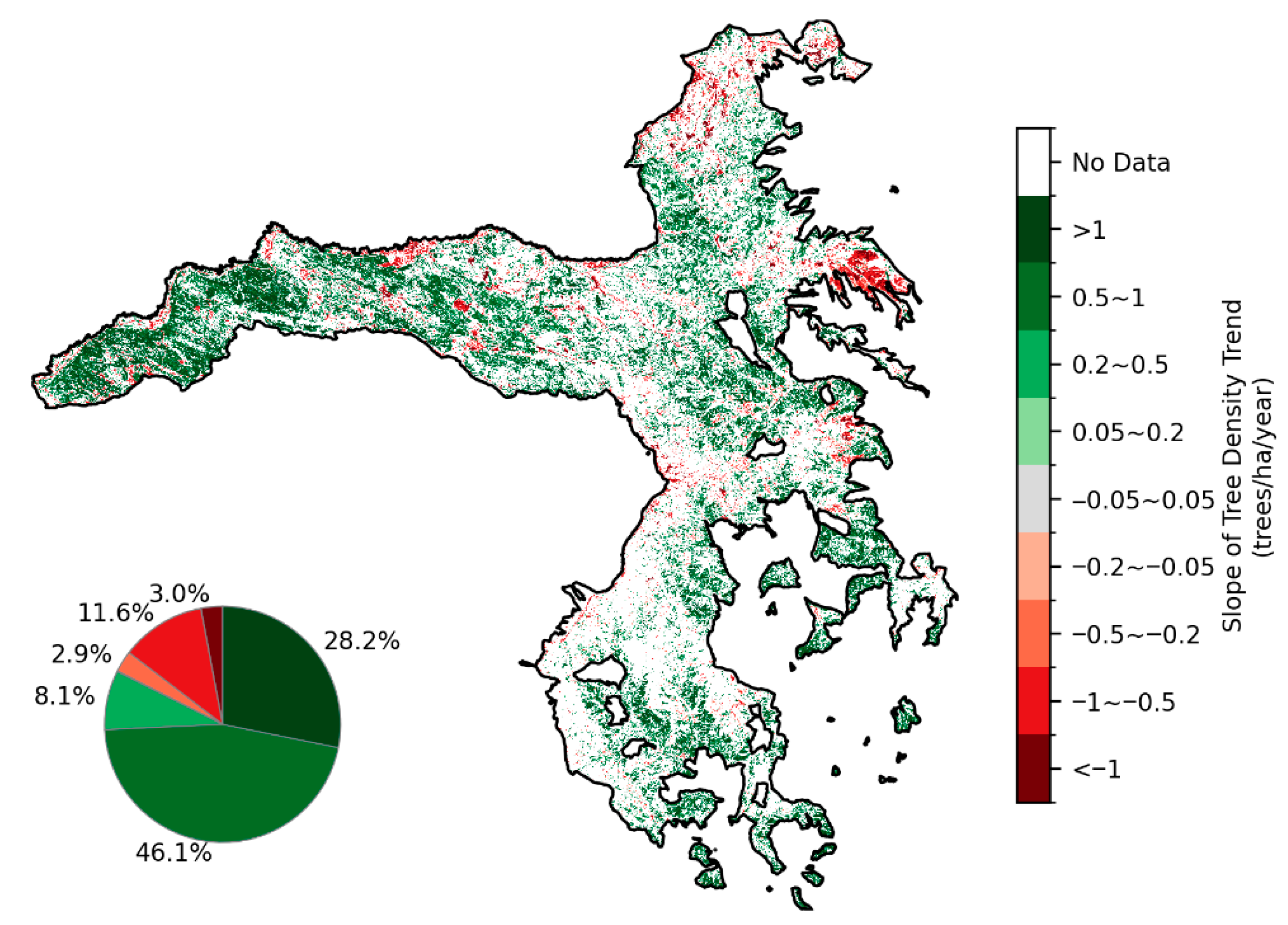
| Band | Landsat 5 TM (μm) | Landsat 8 OLI (μm) |
|---|---|---|
| Blue | Band 1 (0.45–0.52) | Band 2 (0.45–0.51) |
| Green | Band 2 (0.52–0.60) | Band 3 (0.53–0.59) |
| Red | Band 3 (0.63–0.69) | Band 4 (0.64–0.67) |
| Near-Infrared (NIR) | Band 4 (0.76–0.90) | Band 5 (0.85–0.88) |
| Short-Wave Infrared I | Band 5 (1.55–1.75) | Band 6 (1.57–1.65) |
| Short-Wave Infrared II | Band 7 (2.08–2.35) | Band 7 (2.11–2.29) |
Disclaimer/Publisher’s Note: The statements, opinions and data contained in all publications are solely those of the individual author(s) and contributor(s) and not of MDPI and/or the editor(s). MDPI and/or the editor(s) disclaim responsibility for any injury to people or property resulting from any ideas, methods, instructions or products referred to in the content. |
© 2025 by the authors. Licensee MDPI, Basel, Switzerland. This article is an open access article distributed under the terms and conditions of the Creative Commons Attribution (CC BY) license (https://creativecommons.org/licenses/by/4.0/).
Share and Cite
Wang, N.; Xie, D.; Jin, L.; Li, Y.; Mu, X.; Yan, G. Unveiling Forest Density Dynamics in Saihanba Forest Farm by Integrating Airborne LiDAR and Landsat Satellites. Remote Sens. 2025, 17, 3338. https://doi.org/10.3390/rs17193338
Wang N, Xie D, Jin L, Li Y, Mu X, Yan G. Unveiling Forest Density Dynamics in Saihanba Forest Farm by Integrating Airborne LiDAR and Landsat Satellites. Remote Sensing. 2025; 17(19):3338. https://doi.org/10.3390/rs17193338
Chicago/Turabian StyleWang, Nan, Donghui Xie, Lin Jin, Yi Li, Xihan Mu, and Guangjian Yan. 2025. "Unveiling Forest Density Dynamics in Saihanba Forest Farm by Integrating Airborne LiDAR and Landsat Satellites" Remote Sensing 17, no. 19: 3338. https://doi.org/10.3390/rs17193338
APA StyleWang, N., Xie, D., Jin, L., Li, Y., Mu, X., & Yan, G. (2025). Unveiling Forest Density Dynamics in Saihanba Forest Farm by Integrating Airborne LiDAR and Landsat Satellites. Remote Sensing, 17(19), 3338. https://doi.org/10.3390/rs17193338








